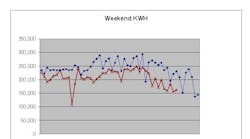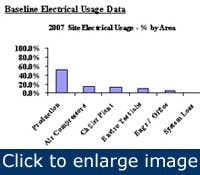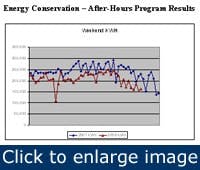Trane Inc., a provider of energy-efficient systems and solutions for buildings, is also actively engaged in reducing energy consumption at its own facilities. In 2007, Trane enacted a program to identify energy conservation opportunities in its Tyler, Texas, production facility, the headquarters of Trane Residential Systems.
This paper discusses the analysis process and the implementation of an energy management program with plan elements that include policy decisions, behavior changes, process changes, replacement projects, and improved operations and maintenance practices.
The energy management program team identified a phased investment plan, requesting and receiving a $2.1 million investment for Phase 1 implementation, in anticipation of $1.1 million in recurring annual energy cost reductions beginning in 2009.
|
View related content on PlantServices.com |
Drivers for change in Tyler energy strategy
Adverse economic conditions in 2007 elevated energy management to the top of the list of financial priorities:
- Housing starts fell dramatically; residential air-conditioning equipment is the primary product of the plant
- The Tyler site’s long-term electric contract was scheduled to expire within a year; proposals indicated potential for a 70% rate increase on a $4 million electric bill
- Cost-reduction pressure, headcount reductions and the reprioritization of work resulted in a lack of process focus on energy and O&M effectiveness
Facilities/infrastructure
- Campus-style facility with approximately 1.1 million square feet of manufacturing, environmental testing and engineering design/office space
- Two compressor air systems: one at 100 psi for general plant air and one at 400 psi for testing (5,000 cfm total capacity at -400°F dew point)
- Four 900-ton Trane centrifugal chillers running in series/parallel, operating at 38°F
- 2400-ton process cooling tower water
- 1-600 hp and 1-35 hp gas-fired boilers
Approach to the problem
Tyler site management elected to implement a four-step process focusing on:
- Policy deployment tools
— Factory awareness program
— Electrical sub-metering for accountability
— Ownership of results and empowerment
— Metrics, monitoring and reporting
- [pullquote]
- Energy conservation measures
— Behavior changes
— Off /on controls
— Basic operations and maintenance
- Energy and process efficiency
— Equipment/systems efficiency
— Production methods
— Waste minimization, leaks and losses
- Pricing strategies
— Supply/rate management
— Demand management
— Off-peak load shifting
Policy deployment
- Utilize metering data available from the 15kV/480V electrical transformers to determine where energy was being used (by building area and manufacturing module, where possible)
- Selected metric of kW/unit produced and deployed by manufacturing module, where possible; energy performance added to the monthly manufacturing management staff meeting agenda
- Accounting change contemplated to measure manufacturing module energy use
Conducted facility infrastructure assessment
- Two externally heated desiccant dryers (6,000 SCFM total capacity) consume 8% of total compressed air plant generation capacity for dryer regeneration — venting directly to atmosphere
- Identified aging air handler equipment with poor heat transfer and/or inadequate for the applications and environments they support — 2009 Capital Plan
- Reset HVAC area controls to specifications in the factory and addressed capacity issues rather than operating chilled water plant to drive down overall building temperature
- Water treatment system for the chilled and process water cooling towers, resulting in excessive fouling of cooling water support systems
- 600 hp boiler, circa 1968, greatly oversized for current process requirements
Energy conservation measures
Planning
- Team discussed the need to change the behavior of the production workforce and involve people in energy conservation efforts
- Discussed the “project as opposed to process” nature of people involvement programs for energy conservation
Initiatives
- Off-shift and weekend power management program was developed to turn off manufacturing equipment when not required resulting in $150,000 annualized savings
- Set in place operations and maintenance (O&M) campaign to find and fix compressed air leaks during planned manufacturing maintenance
Energy and process efficiency
New IR air compressors/dryers/header, $400,000 annualized
- Authorized $1.1 million for replacement air compressor equipment, using four new Ingersoll Rand 300 HP rotary screw air compressors, dryers and new six-inch header enabling pressure reduction and eliminating dryer venting to atmosphere
Lighting retrofit projects, $125,000 in 2008 ($300,000 annualized for total lighting retrofit projects)
- Lighting retrofit opportunities
— Metal halide high bay lighting replaced with high-efficiency fluorescent lighting
— T12 florescent lighting replacement plan engineering/office areas
Boiler replacement, $150,000 annualized
- Replaced 600 HP boiler at 70% efficiency with a 400 HP at 90% efficiency. Completed December 2008; $300,000 investment, $150,000 annualized savings
Revised HVAC O&M processes, $180,000 annualized
- Plant temperature specifications
- Chiller/cooling tower improvements
- Raised chilled water supply temperature from 38F to 43F on shift and 49F off shift
- O&M practices — heat transfer/controls adjustments
- Added HVAC O&M supervisor on-site
Monitoring and remote engineering analysis, $125,000 annualized
- Leveraged Trane National Service, Central Monitoring Center
— Analyze operating conditions and support night and weekend and operations issues
— Reduced off-shift stand-by operations staff and added high caliber support to first shift
Pricing strategies
- Capital Procurement Team was commissioned to conduct a rate analysis, using contracted supply side consultants
- Market pricing for electricity in 2008 varied in cost from $0.085 to $0.133. A new forward market pricing strategy was implemented in 2008 to lock in cost of a percentage of expected usage and hedge the balance
Conclusion
One of the critical issues overcome by the team was in achieving good teamwork and “Dual Citizenship.” Everyone involved in the process, Residential Systems, Commercial Systems and Ingersoll Rand, took a global view, regardless of departmental goals, recognizing energy management as an important common goal.
Multiple benefits are being achieved from this program, including improved O&M practices, the use of remote monitoring and engineering support to reduce cost and “hold the gains”, as well as delivering better-than-expected raw cost avoidance of approximately $480,000, including over $100,000 in energy cost avoidance from improved chiller plant and HVAC operation and maintenance.
Paul Wheeler has extensive experience in facilities engineering supporting the electronics and automotive industries, including eight years developing operations and maintenance solutions for Trane customers. He is a professional engineer in Texas, and an honors graduate of the University of Texas at Austin, with a Bachelor's degree in electrical engineering. Contact him at [email protected] and (972) 406-3652.



